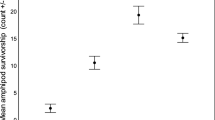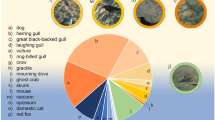Abstract
Feeding interactions with invaders have powerful impacts on native biota. Recently, a trophic interaction among invasive green crabs (Carcinus maenas) and native dogwhelks (Nucella lapillus) foraging on mussels (Mytilus spp.) in Atlantic Canada was reported, in which a mussel initially attacked by a dogwhelk was then eaten by a crab. This was interpreted as kleptoparasitism, but alternatively could be scavenging of abandoned mussel prey. In this paper, mathematical models of kleptoparasitism and scavenging among these species were developed and used to generate predicted feeding rates, which were then compared to observations from previous work. The available evidence for kleptoparasitism by green crabs on dogwhelks was also considered and compared to hypothesized outcomes of these different foraging modes. The evidence considered does not definitively suggest that scavenging was previously misidentified as kleptoparasitism; in fact, model simulations were only able to match observed foraging when they included kleptoparasitism. Effects of crab kleptoparasitism on whelks were shown to be negative, while crab scavenging had effectively no impact on whelks; therefore, while these two foraging interactions appear superficially similar, they have very different implications and should be carefully distinguished in future studies.





Similar content being viewed by others
References
Ahrens WH, Cox DJ, Budhwar G (1990) Use of the arcsine and square root transformations for subjectively determined percentage data. Weed Sci 38:452–458
Anderssen M (1976) Predation and kleptoparasitism by skuas in a Shetland seabird colony. Ibis 118:208–217
Aschaffenberg MD (2008) Different crab species influence feeding of the snail Nucella lapillus through trait-mediated indirect interactions. Mar Ecol 29:348–353
Barnard CJ, Sibly RM (1981) Producers and scroungers: a general model and its application to feeding flocks of house sparrows. Anim Behav 29:543–550
Beal BF (2006) Relative importance of predation and intraspecific competition in regulating growth and survival of juveniles of the soft-shell clam, Mya arenaria L., at several spatial scales. J Exp Mar Biol Ecol 336:1–17
Boudreau MR (2011) Interactions between predators within an intertidal mussel bed community. MSc thesis. Mount Allison University, Canada
Boudreau MR, Hamilton DJ (2012) Seasonal variation in effects of multiple predators on an intertidal mussel bed: implications for interpretation of manipulative experiments. Mar Ecol Prog Ser 465:137–153
Boudreau ML, Boudreau MR, Hamilton DJ (2013) The influence of body size on foraging facilitation and kleptoparasitic behavior in the green crab (Carcinus maenas). J Exp Mar Biol Ecol 449:330–334
Branch GM, Steffani CN (2004) Can we predict the effects of alien species? A case-history of the invasion of South Africa by Mytilus galloprovincialis (Lamarck). J Exp Mar Biol Ecol 300:189–215
Brown MB, Schlacher TA, Schoeman DS, Weston MA, Huijbers CM, Olds AD, Connolly RM (2015) Invasive carnivores alter ecological function and enhance complementarity in scavenger assemblages on ocean beaches. Ecology 96:2715–2725
Burrows MT, Hughes RN (1991) Optimal foraging decisions by dogwhelks, Nucella lapillus (L.): influences of mortality risk and rate-constrained digestion. Funct Ecol 5:461–475
Carlton JT, Cohen AN (2003) Episodic global dispersal in shallow water marine organisms: the case history of the European shore crabs Carcinus maenas and C. aestuarii. J Biogeogr 30:1809–1820
Carriker MR, Williams LG (1978) The chemical mechanism of shell dissolution by predatory boring gastropods: a review and an hypothesis. Malacologia 17:143–156
Chakravarti LJ, Cotton PA (2014) The effects of a competitor on the foraging behaviour of the shore crab Carcinus maenas. PLoS One 9(4):e93546. doi:10.1371/journal.pone.0093546
Cockrell ML, Bernhardt JR, Leslie HM (2015) Recruitment, abundance, and predation on the blue mussel (Mytilus edulis) on northeastern estuarine rocky shores. Ecosphere 6(1):18. doi:10.1890/ES14-00176.1
Crothers JH (1968) The biology of the shore crab Carcinus maenas (L.) 2. The life of the adult crab. Field Stud 2:579–614
Crothers JH (1985) Dog-whelks: an introduction to the biology of Nucella lapillus (L.). Field Stud 6:291–360
Elbroch LM, Lendrum PE, Allen ML, Wittmer HU (2015) Nowhere to hide: pumas, black bears, and competition refuges. Behav Ecol 26:247–254
Enderlein PS, Moorthi S, Röhrscheidt H, Wahl M (2003) Optimal foraging versus shared doom effects: interactive influence of mussel size and epibiosis on predator preference. J Exp Mar Biol Ecol 292:231–242
Fodrie FJ, Brodeur MC, Toscano BJ, Powers SP (2012) Friedn or foe: conflicting demands and conditional risk taking by opportunistic scavengers. J Exp Mar Biol Ecol 422–423:114–121
Fourvel J-B, Fosse P, Avery G (2015) Spotted, striped or brown? Taphonomic studies at dens of extant hyaenas in eastern and southern Africa. Quat Int 369:38–50
Getz WM (2011) Biomass transformation webs provide a unified approach to consumer-resource modelling. Ecol Lett 14:113–124
Gherardi F (2007) Understanding the impact of invasive crayfish. In: Gherardi F (ed) Biological invaders in inland waters: profiles, distribution, and threats. Springer, Dordrecht, pp 697–702
Grosholz E, Ruiz GM, Dean CA, Shirely KA, Maron JL, Connnors PG (2000) The impacts of a nonindigenous marine predator in a California bay. Ecology 81:1206–1224
Haarr ML, Rochette R (2012) The effect of geographic origin on interactions between adult invasive green crabs carcinus maenas and juvenile American lobsters Homarus americanus in Atlantic Canada. J Exp Mar Biol Ecol 422–423:88–100
Hamilton DJ (2000) Direct and indirect effects of predation by common eiders and abiotic disturbance in an intertidal community. Ecol Monogr 70:21–43
Höner OP, Wachter B, East ML, Hofer H (2002) The response of spotted hyaenas to long-term changes in prey populations: functional response and interspecific kleptoparasitism. J Anim Ecol 71:236–246
Hughes RN, SdeB Dunkin (1984) Behavioural components of prey selection by dogwhelks, Nucella lapillus (L.), feeding on mussels, Mytilus edulis L., in the laboratory. J Exp Mar Biol Ecol 77:45–68
Ishida S (2004) Initial predation and parasitism by muricid whelks demonstrated by the correspondence between drilled holes and their apparent enveloper. J Exp Mar Biol Ecol 305:233–245
Iyengar EV (2008) Kleptoparasitic interactions throughout the animal kingdom and a re-evaluation, based on participant mobility, of the conditions promoting the evolution of kleptoparasitism. Biol J Linn Soc 93:745–762
Kerr AM (2005) Behavior of web-invading spiders Argyrodes argentatus (Theridiidae) in Argiope appensa (Araneidae) host webs in Guam. J Arachnol 33:1–6
Klassen G, Locke A (2007) A biological synopsis of the European green crab, Carcinus maenas. Can Manuscr Rep Fish Aquat Sci 2818:1–75
Mattisson J, Andrén H, Persson J, Segerström P (2011) Influence of intraguild interactions on resource use by wolverines and Eurasian lynx. J Mammal 92:1321–1330
Menge BA, Branch GM (2001) Rocky intertidal communities. In: Bertness MD, Gaines SD, Hay ME (eds) Marine Community Ecology. Sinauer, Sunderland, pp 221–251
Menge BA, Sutherland JP (1976) Species diversity gradients: synthesis of the roles of predation, competition, and temporal heterogeneity. Am Nat 110:351–369
Morissette S, Himmelman JH (2000) Subtidal food thieves: interactions of four invertebrate kleptoparasites with the sea star Leptasterias polaris. Anim Behav 60:531–543
Morse DH (2001) Harvestmen as commensals of crab spiders. J Arachnol 29:273–275
Morton B (2010) Predator-prey interactions between a population of Nucella lapillus (Gastropoda: Muricidae) recovering from imposex and Mytilus galloprovincialis (Bivalvia: Mytilidae) on the south-east coast of England. J Mar Biol Assoc UK 90:671–681
Morton B (2011) Predator-prey-scavenging interactions between Nucella lapillus, Carcinus maenas and Eulalia viridis all exploiting Mytilus galloprovincialis on a rocky shore recovering from tributyl-tin (TBT) pollution. J Nat Hist 45:2397–2417
Morton B, Jones DS (2001) The biology of Hipponix australis (Gastropoda: Hipponicidae) on Nassarius pauperatus (Nassariidae) in Princess Royal Harbour, Western Australia. J Mollus Stud 67:247–255
Norris K, Johnstone I (1998) Interference competition and the functional response of oystercatchers searching for cockles by touch. Anim Behav 56:639–650
Osorno JL, Torres R, Gracia MS (1992) Kleptoparasitic behaviour of the magnificent frigate bird: sex bias and success. Condor 94:692–698
Preisler RK (2010) Biogeographic variation in abundance, habitat, and behavior of the European green crab, Carcinus maenas. PhD thesis. University of California, Santa Cruz, USA
Quinn BK (2010) Inter- and intra-specific interactions among invertebrate predators feeding on blue mussels, Mytilus edulis. BSc (Honours) thesis. Mount Allison University, Canada
Quinn BK, Boudreau MR, Hamilton DJ (2012) Inter- and intra-specific interactions among green crabs (Carcinus maenas) and whelks (Nucella lapillus) feeding on blue mussels (Mytilus edulis). J Exp Mar Biol Ecol 412:117–125
Rawson PD, Hayhurst S, Vanscoyoc B (2001) Species composition of blue mussel populations in the northeastern Gulf of Maine. J Shellfish Res 20:31–38
Schofield PJ (2010) Update on geographic spread of invasive lionfishes (Pterois volitans [Linnaeus, 1758] and P. miles [Bennet, 1828]) in the Western North Atlantic Ocean, Caribbean Sea and Gulf of Mexico. Aquat Invasions 5(Suppl 1):S117–S122
Sih A, Crowley P, McPeek M, Petranka J, Strohmeier K (1985) Predation, competition, and prey communities: a review of field experiements. Ann Rev Ecol Syst 16:269–311
Smallegange IM, van der Meer J, Kurvers RHJM (2006) Disentangling interference competition from exploitation competition in a crab-bivalve system using a novel experimental approach. Oikos 113:157–167
Snyder WE, Evans EW (2006) Ecological effects of invasive arthropod generalist predators. Annu Rev Ecol Evol Syst 37:95–122
Trussell GC, Ewanchuck PJ, Bertness MD (2003) Trait-mediated effects in rocky intertidal food chains: predator risk cues alter prey feeding rates. Ecology 84:629–640
Vadas RL, Burrows MT, Hughes RN (1994) Foraging strategies of dogwhelks, Nucella lapillus (L.): interacting effects of age, diet and chemical cues to the threat of predation. Oecologia 100:439–450
Vollrath F (1984) Kleptobiotic interactions in invertebrates. In: Barnard CJ (ed) Producers and scroungers: strategies of exploitation and parasitism. Croom-Helm, London, pp 61–94
Wilmer CC, Post E (2006) Predicting the influence of wolf-provided carrion on scavenger community dynamics under climate change scenarios. Glob Change Biol 12:403–409
Wong MC, Dowd M (2015) Role of invasive green carbs in the food web of an intertidal sand flat determined from field observations and a dynamic simulation model. Estuaries Coasts 37:1004–1016
Wong MC, d’Entremont J, Barbeau M (2012) An approach for quantifying effects of multiple predators that forage on different time scales. J Exp Mar Biol Ecol 420–421:100–109
Yamahira K, Yano F (2000) Distribution of the bonnet limpet, Hipponix conicus (Gastropoda: Hipponicidae), among host species in western Kyushu, Japan. Veliger 43:72–77
Acknowledgments
Extensive thanks are due to Diana J. Hamilton and Melanie L. Boudreau for permission to use unpublished data and to three anonymous reviewers for comments that improved this manuscript. Computational resources were provided to BKQ through Information Technology Services and Department of Computer Sciences and Applied Statistics of the University of New Brunswick, Saint John Campus.
Author information
Authors and Affiliations
Corresponding author
Ethics declarations
Conflict of interest
Both authors declare that they have no conflict of interest.
Ethical approval
This article does not contain any studies with animals or human participants performed by any of the authors.
Additional information
Responsible Editor: M.G. Chapman.
Reviewed by Undisclosed experts.
This article is part of the Topical Collection on Invasive Species.
Rights and permissions
About this article
Cite this article
Quinn, B.K., Boudreau, M.R. Kleptoparasitism and scavenging by the invasive green crab (Carcinus maenas) have different impacts on native species. Mar Biol 163, 186 (2016). https://doi.org/10.1007/s00227-016-2964-1
Received:
Accepted:
Published:
DOI: https://doi.org/10.1007/s00227-016-2964-1




